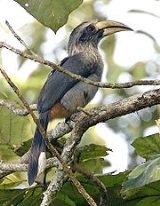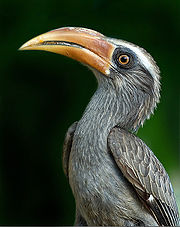
Malabar Grey Hornbill
Encyclopedia
The Malabar Grey Hornbill, Ocyceros griseus, is a hornbill
that is endemic to the Western Ghats
and associated hills of southern India. They have a large beak but lack the casque that is prominent in other species of hornbills. They are found mainly in dense forest and around rubber, arecanut or coffee plantations. They move around in small groups, feeding on figs and other forest fruits. Their loud cackling and laughing call makes them familiar to people living in the region.
 The Malabar Grey Hornbill is a large bird, at 45 cm in length with a 23 cm tail and pale or yellowish to orange bill. Males have a reddish bill with a yellow tip while the females have a plain yellow bill with black at the base of the lower mandible and a black stripe along the culmen. They show a broad whitish superciliary band above the eye running down to the neck. They fly with a strong flap and glide flight and hop around heavily on the outer branches of large fruiting trees. They has brown-grey wings, a white carpal patch and black primary flight feathers tipped with white. The Indian Grey Hornbill
The Malabar Grey Hornbill is a large bird, at 45 cm in length with a 23 cm tail and pale or yellowish to orange bill. Males have a reddish bill with a yellow tip while the females have a plain yellow bill with black at the base of the lower mandible and a black stripe along the culmen. They show a broad whitish superciliary band above the eye running down to the neck. They fly with a strong flap and glide flight and hop around heavily on the outer branches of large fruiting trees. They has brown-grey wings, a white carpal patch and black primary flight feathers tipped with white. The Indian Grey Hornbill
which is found mainly on the adjoining plains is easily told apart by its prominent casque and in flight by the white trailing edge to the entire wing. The Malabar Grey Hornbill has a grey back, and a cinnamon vent. The long tail is blackish with a white tip, and the underparts are grey with white streaks. The long curved bill has no casque. Immature birds have browner upperparts and a yellow bill. Young birds have a dull white or yellow iris.
Their loud calls are distinctive and include "hysterical cackling", "laughing" and "screeching" calls.
and associated hills of southern India
. They are mainly found in dense forest habitats and the thinner dry forest habitat of the plains is typically occupied by the Indian Grey Hornbill. In the past the Sri Lanka Grey Hornbill
was included with this species but is now considered distinct.
agents for many species of fruit bearing forest trees. They also feed on small vertebrates and in captivity they will readily take meat.
showed that the species preferred nest sites that had large trees. The nest holes were usually found in large trees with hollows caused by heart-rot where a branch had broken off. Trees of the species Lagerstroemia microcarpa, Terminalia bellirica and Terminalia crenulata were found to hold nearly 70% of all the nests in the Mudumalai area. The species is monogamous and the same nest sites are used by the pair year after year. The female incarcerates herself within the cavity by sealing its entrance with a cement made from her droppings. The female then lays three or sometimes four white eggs and begins a complete moult
of her flight feathers. The entrance to the nest retains a narrow aperture through which the female voids excreta and receives food from the male. The male bring all the food needed for the female and the young. Berries, insects, small rodents and reptiles are included in the diet. Males tap the tree to beckon the female on arriving with food. Berries are regurgitated one at a time and shifted to the tip of the bill before being passed to the female.
Hornbill
Hornbills are a family of bird found in tropical and subtropical Africa, Asia and Melanesia. They are characterized by a long, down-curved bill which is frequently brightly-colored and sometimes has a casque on the upper mandible. Both the common English and the scientific name of the family...
that is endemic to the Western Ghats
Western Ghats
The Western Ghats, Western Ghauts or the Sahyādri is a mountain range along the western side of India. It runs north to south along the western edge of the Deccan Plateau, and separates the plateau from a narrow coastal plain along the Arabian Sea. The Western Ghats block rainfall to the Deccan...
and associated hills of southern India. They have a large beak but lack the casque that is prominent in other species of hornbills. They are found mainly in dense forest and around rubber, arecanut or coffee plantations. They move around in small groups, feeding on figs and other forest fruits. Their loud cackling and laughing call makes them familiar to people living in the region.
Description

Indian Grey Hornbill
The Indian Grey Hornbill is a common hornbill found on the Indian subcontinent. It is mostly arboreal and is commonly sighted in pairs. They have grey feathers all over the body with a light grey or dull white belly. The horn is black or dark grey with a casque extending up to the point of...
which is found mainly on the adjoining plains is easily told apart by its prominent casque and in flight by the white trailing edge to the entire wing. The Malabar Grey Hornbill has a grey back, and a cinnamon vent. The long tail is blackish with a white tip, and the underparts are grey with white streaks. The long curved bill has no casque. Immature birds have browner upperparts and a yellow bill. Young birds have a dull white or yellow iris.
Their loud calls are distinctive and include "hysterical cackling", "laughing" and "screeching" calls.
Distribution
The Malabar Grey Hornbill is a common resident breeder in the Western GhatsWestern Ghats
The Western Ghats, Western Ghauts or the Sahyādri is a mountain range along the western side of India. It runs north to south along the western edge of the Deccan Plateau, and separates the plateau from a narrow coastal plain along the Arabian Sea. The Western Ghats block rainfall to the Deccan...
and associated hills of southern India
India
India , officially the Republic of India , is a country in South Asia. It is the seventh-largest country by geographical area, the second-most populous country with over 1.2 billion people, and the most populous democracy in the world...
. They are mainly found in dense forest habitats and the thinner dry forest habitat of the plains is typically occupied by the Indian Grey Hornbill. In the past the Sri Lanka Grey Hornbill
Sri Lanka Grey Hornbill
The Sri Lanka Grey Hornbill is a hornbill and a widespread and common endemic resident breeder in Sri Lanka. Hornbills are a family of tropical near-passerine birds found in the Old World....
was included with this species but is now considered distinct.
Behaviour and ecology
This hornbill is found in small groups mainly in habitats with good tree cover and being large frugivores, they are important as seed dispersalSeed dispersal
Seed dispersal is the movement or transport of seeds away from the parent plant. Plants have limited mobility and consequently rely upon a variety of dispersal vectors to transport their propagules, including both abiotic and biotic vectors. Seeds can be dispersed away from the parent plant...
agents for many species of fruit bearing forest trees. They also feed on small vertebrates and in captivity they will readily take meat.
Breeding
The breeding season is January to May. Being secondary cavity nesters (incapable of excavating their own nests), the find trees with large cavities. A study in the Anaimalai HillsAnaimalai Hills
The Anaimalai Hills is a range of mountains in the Western Ghats in Tamil Nadu and Kerala states of South India. The name "Anaimalai" derives from the Tamil word 'Ana' meaning elephant and 'Mala' meaning hill, thus Elephant Hill. The highest peak of the Anaimalai Hills is Anamudi, , located in the...
showed that the species preferred nest sites that had large trees. The nest holes were usually found in large trees with hollows caused by heart-rot where a branch had broken off. Trees of the species Lagerstroemia microcarpa, Terminalia bellirica and Terminalia crenulata were found to hold nearly 70% of all the nests in the Mudumalai area. The species is monogamous and the same nest sites are used by the pair year after year. The female incarcerates herself within the cavity by sealing its entrance with a cement made from her droppings. The female then lays three or sometimes four white eggs and begins a complete moult
Moult
In biology, moulting or molting , also known as sloughing, shedding, or for some species, ecdysis, is the manner in which an animal routinely casts off a part of its body , either at specific times of year, or at specific points in its life cycle.Moulting can involve the epidermis , pelage...
of her flight feathers. The entrance to the nest retains a narrow aperture through which the female voids excreta and receives food from the male. The male bring all the food needed for the female and the young. Berries, insects, small rodents and reptiles are included in the diet. Males tap the tree to beckon the female on arriving with food. Berries are regurgitated one at a time and shifted to the tip of the bill before being passed to the female.
External links
- Internet Bird Collection
- Wieke Galama, Catherine King, Koen Brouwer (2002) EAZA Hornbill Management and Husbandry Guidelines. National Foundation for Research in Zoological Gardens. download

